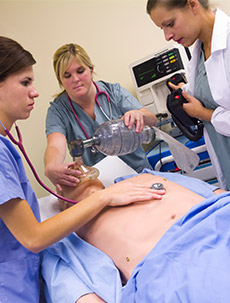 Thanks to the generosity of a local couple, Conestoga students preparing for health-care careers are using high-end technology to learn and perfect the techniques they will later need to serve their real-life patients.
Thanks to the generosity of a local couple, Conestoga students preparing for health-care careers are using high-end technology to learn and perfect the techniques they will later need to serve their real-life patients.
The state-of-the-art Cross Centre for Simulation Learning (CCSL), supported in large part by Larry and Glenna Cross, is a high-tech training ground for more than 3,000 students across a number of health-care disciplines, including nursing, health sciences, informatics, life sciences, community safety, and community service.
The centre consists of six simulation suites, each with its own debriefing room along with a main control room and a prep area. The facility is designed to mimic a real hospital setting, allowing students to immerse themselves in the professional roles they are working towards.
Instead of live patients, students work with high-fidelity mannikins, human patient simulators with the ability to breathe, blink, show pain, speak, and most importantly, teach.
All the mannikins have working pulses, hearts, bowels and lungs. They can represent a myriad of health conditions from mild to critical and life-threatening.
According to Gary Sheppard, manager of inter-professional resources for Conestoga's School of Health and Life Sciences, use of the mannikins provides tremendous training advantages.
"You can really bring high-risk events - situations that may not present themselves during a clinical learning situation - to life for students and allow for discussion afterwards," said Sheppard.
Simulation occurs in real time and does not stop if mistakes are made. The surrogate patients respond based on computer-generated symptoms and may recover, survive or die, depending on the treatment they receive during the simulation exercises.
"The students are allowed to make mistakes during the simulations. The exercises are there to test their clinical reasoning, judgement and decision making skills."
Video of the activity inside the simulation room can be recorded and transmitted to a neighbouring classroom to allow students and faculty to observe procedures and techniques, as well as provide opportunities for critical reflection and feedback.
According to Sheppard, the hands-on practice that Conestoga students receive in the simulation centre makes a real difference in preparing students for successful health-care careers.
Academic integrity
Accessible Learning
eConestoga
Global opportunities
Library & Learning Services
Program technology requirements
Student tech help
Tutoring & academic help
Ask for help
Counselling
Indigenous Services
Medical Clinic
Remote service hours
Student Financial Services
Student Rights and Responsibilities
Sexual & gender-based violence support
Athletics & Recreation
Co-Curricular Record (CCR)
CSI - Student association
Orientation
Student Engagement
Overview
Corporate information
Research & innovation
Indigenous
College initiatives
Academic schools
Campuses & locations
Administration
Careers at Conestoga
Doing business with Conestoga
Giving to Conestoga
Governance
Institutional research
Policies & procedures
Reports
Strategic Plan
